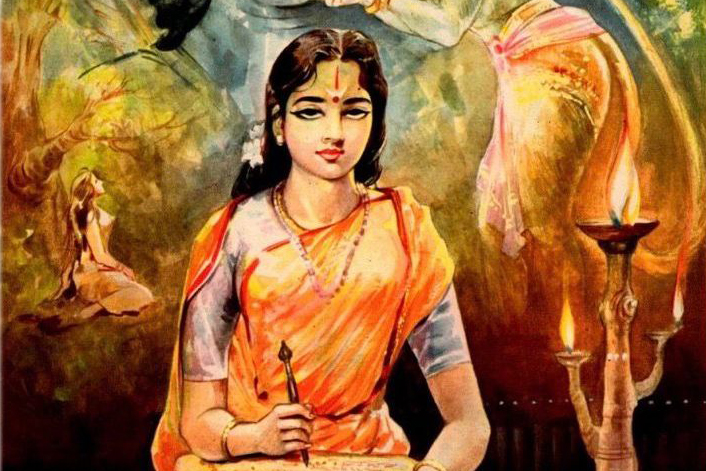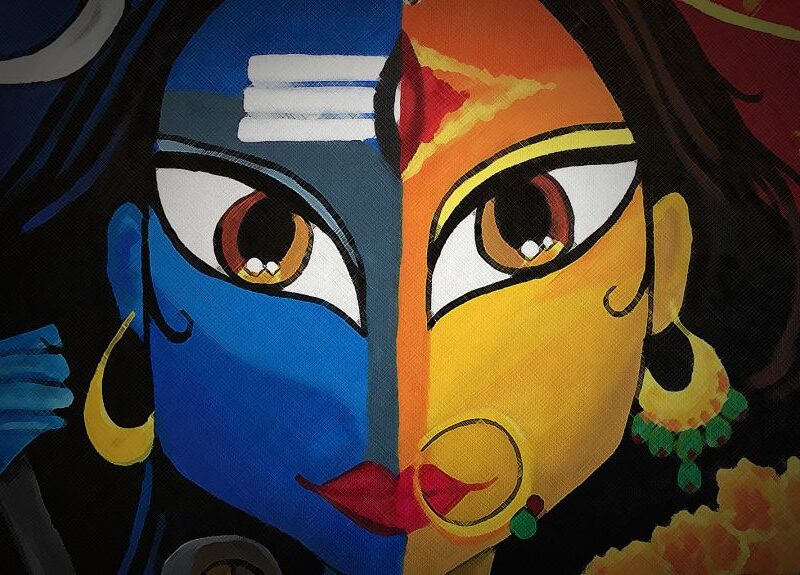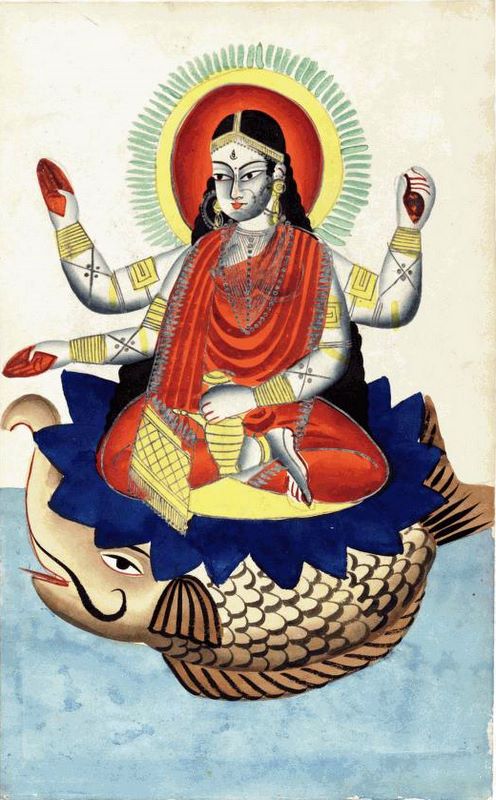
“The Ramayana has been written many times. But does someone stop taking food because it has been taken every day? So is the story of Rama and one can write, read and love it as many times as possible.”
The wonderful words above are by Atukuri Molla, one of the greats of Telugu literature who abridged and adapted the Sanskrit Valmiki Ramayana into Telugu.
The primary objective of this series is to highlight lesser known saints of Hinduism and India. A secondary objective is to emphasize that it is incumbent upon Hindus to learn about, highlight and actively celebrate all of our saints and philosophers.
We will realize, contrary to Marxist and missionary scholarship, nay propaganda, that our saints came from all socio-economic backgrounds, that spiritual knowledge, piety and sainthood were never the sole preserve of a small section of society. Our heroine today is a shining example of this.
Biography
Atukuri Molla was born on 13th March 1440 in Gopavaram village of Nellore district in today’s Andhra Pradesh state. Her father Atukuri Kesana Setty was a Shaivaite and devotee of Lord Malleswara of Srisailam. He named his daughter Molla after the jasmine flower dear to Lord Shiva.
Molla was pious from a young age and became a brahmacharini upon the recommendation of her father’s guru. Although she was a lifelong devotee of Lord Shiva, she once had a vision of Sri Rama while meditating, asking her to compose her own Ramayana. She began work right away, and produced a beautiful Ramayana in Telugu language that is highly regarded by scholars for the quality of its poetry. People from the neighboring villages would come and listen to her, and the work came to be known as the Molla Ramayana
As her fame spread, the great King Krishnadeva Raya of the Vijayanagara empire invited her to his court to recite her Ramayana. It is said that the king, who was himself a great scholar, was wonderstruck at the quality of verse of the Molla Ramayana. And similar to many other stories of great Indian poets, Molla was challenged by the many poets assembled in the King’s court to produce a poem extemporary, as a means of testing her knowledge and skill. She was asked to compose a poem in a specific meter on the Gajendra the elephant devotee of Lord Vishnu. With a humble prayer to Sri Rama, she sang a glorious poem that silenced skeptics. Krishnadevaraya conferred upon her the title of “Kavi Ratna”.
Not much more is known about the simple life of Atukuri Molla. She is said to have lived the rest of her simple life in the presence of her family deity Lord Shiva in the temple town of Srisailam, singing her Ramayana serving as a source of inspiration to the people of nearby villages. She merged with her Lord in 1530 at the ripe old age of 90.
Vijayanagara
There is a lot that one can infer from her life about the great king Krishnadeva Raya and the Vijayanagar empire. The Vijayanagar empire is considered the golden age of classical Telugu literature. But Molla’s life Has so many features that are contrary to commonly held perceptions about the state of Hindu society. One has to conclude, at the very least, that society was very different in a Hindu Kingdom like Vijayanagara compared to regions ruled by various Muslim sultanates.
For here we find a low caste woman composing poetry of the highest quality in Telugu based on the Sanskrit Valmiki Ramayana and finding a ready audience not only in the King’s court but also in nearby villages. Does it not at a minimum indicate the access to education available widely in the Kingdom? As well as the fact that caste and gender were no bar for the daughter of a potter to become one of the foremost poets of classical Telugu literature?
My personal opinion of the greatness of king Krishnadeva Raya was always very high but learning about Atukuri Molla has only raised the king sky high in my esteem. Apparently, there exists folklore about the guards of the king’s palace dismissing a poet who came to present his work to the king saying that even a kid on the streets of the empire could compose poetry of the quality that the poet presented. Even assuming that such a story is an exaggeration, it makes the point about the education levels and literary quality of the broader society.
There is even more.
Mollamamba (mother Molla) Was also a scholar of Sanskrit and her Ramayana is an abridged translation of Valmiki. She is humble and credits the grace of Sri Kantha Malleshwara, her family deity, for her knowledge of poetry. She says at the beginning of her work that: I am unaware of the treasury of literature, the grammar, the vocabulary and the rules. But I have learnt the art of poetry only through the grace of Srikantha Malleswara, the deity of Gopavaram.
It is clear that this statement is simply her way of paying homage to her Lord. Atukuri Molla In her work pays respects to an entire galaxy of great Sanskrit poets of India — Valmiki, Vyasa, Bharavi, Magha, Bhavabhuti, Bana Bhatta, Siva Bhadra, Kalidasa, Bheema Kavi, Nannayya and Srinatha.
While it is understandable that a commoner would know the names of Valmiki and Vyasa, Molla’s mention of of all these other poets suggests clearly that she is a scholar of Sanskrit as well.
It is not necessary that such knowledge existed in every family but it certainly should disprove the commonly held notion that there was no education outside of the upper castes. Vijayanagara must have been a golden period not just for telugu literature but for all Hindu culture.
The Molla Ramayana
Her narration of Ramayana is crisp and only about 845 verse long. Her Ramayana is unique in that it both differs from, and follows, established literary conventions, showing that Molla was her own master and not afraid to follow her own ideas. Her Ramayana is a mixture of poetry and prose, not just poetry alone. She has also not hesitated to emphasize or elaborate on some parts of Valmiki’s story, and condense others.
For example, her Sundarakanda, which is considered to be an especially beautiful part of her work, is as big as all the earlier kandas combined. And her Yuddha Kanda is larger than even the Sundarakanda. Atukuri Molla completely omits the post-war Uttara Kanda, Further strengthening the view that this kanda was not part of the original Valmiki and was a later interpolation. She has condensed Valmiki’s extensive descriptions of the flora and fauna in his work to focus on the plot. Other episodes overlooked in Molla’s Ramayana include “Lakshman Rekha” episode, which is absent in Valmiki’s version and is a creation of Tulsidas in his Rama Charita Manas. She has also taken the liberty of attributing Rama’s lament and rage after Sita’s abduction to Lakshmana, as it was her strong belief that Rama was an embodiment of poise and that he would not resort to swearing as depicted by Valmiki. These changes give us a sense for how there have come to be over 300 versions of the Ramayana.
Some might expect her to bring a feminine approach to the epic but that isn’t quite so.
Of Bharata Muni’s navarasas (loosely nine emotions, though aesthetic flavors might be more accurate), bhakti (devotion) and karunya (compassion) are often seen to be dominant among women poets. But Molla’s work shows proficiency in all the other 7 rasas as well: shringara (romance/love), veera (heroism), hasyam (comedy), raudra (anger/fury), bhayanaka (terror), adbhuta (wonder, amazement) and bibhatsa (disgust)
Her originality also is reflected in the fact that primarily used simple Telugu and only used Sanskrit words only very rarely, in contrast with other famous Telugu poets.
She says:
“The tongue retains the sweetness only after tasting of honey. The epic should be written only in understandable language. Usage of incomprehensible vocabulary with hidden meanings would be as bad as reciting in front of the deaf and dumb.”
She opens her Ramayana with an invocation to Lord Shiva, breaking the convention of the time, which was to open epic poems with praise of the king who patronized the poet. This clearly shows that she had no royal patronage.
Moreover, Atukuri Molla essentially says that praising lesser kings when one could praise Sri Rama, the best of all kings, would be like choosing bitter ginger over sweet jaggery.
I will end my home to Mollamamba by quoting this translation of one of her verses describing the musings of Guha, Lord Rama’s friend who ferried him across the river Sarayu:
“By virtue of taking upon itself some particles of dust from
The feet of Shri Rama, a stone has become a beautiful woman;
Wondering what a thing his boat would become when touched by it then
Guha washed Shri Rama’s feet clean, fearing within!’
I pray that the dust of Lord Rama’s feet would bless all of mankind today.”
PS: The English translations are Mollamamba’s verses and words and some factual details about the Molla Ramayana are from the blog “History under your feet”.








































